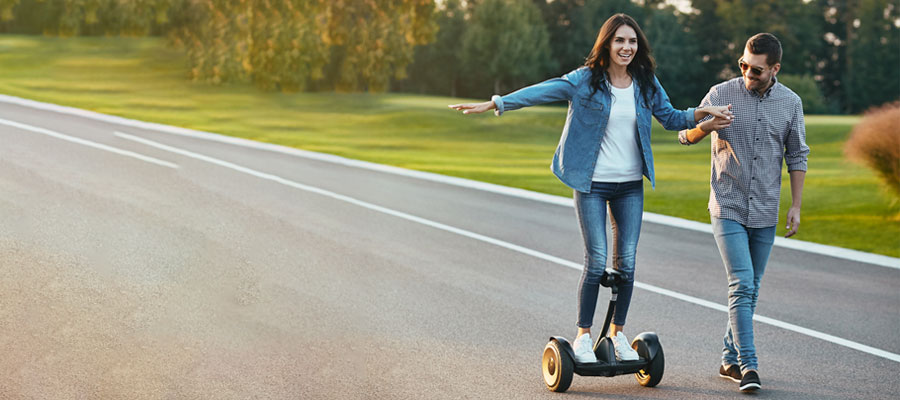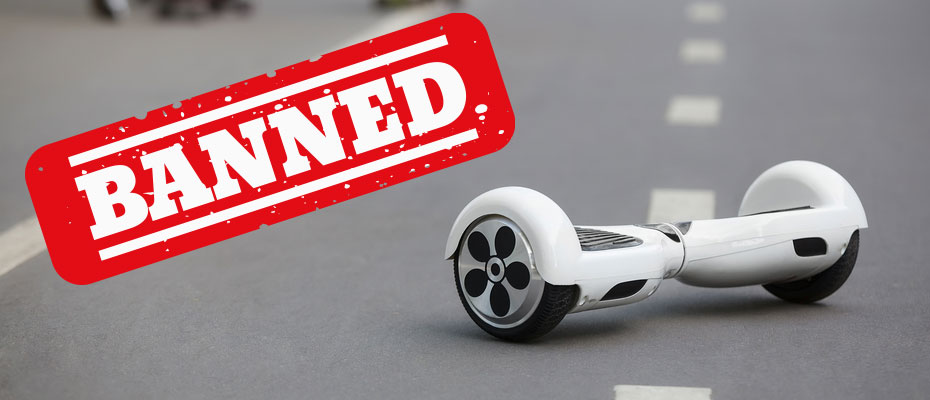Operated hands-free, hoverboards are nifty battery-powered, two-wheeled gadgets that have won many hearts, and broken many bones since 2015! Using a hoverboard has been described as anywhere from a euphoric moment of perfect balance and coordination to a thoughtful Christmas gift that ended with a trip to the ER.
Love them or hate them, hoverboards have made an impact. Propelling willing pilots to speeds of up to 15 miles per hour, and elevating curiosity of folk as to do they really ‘hover’ at all. The hoverboard has plenty of good points, but they also have a reputation of leaving unsuspecting users bruised, battered, and in the past, on fire.
1) They can be tricky to master

It’s fair to say that hoverboards aren’t for everyone, and if you struggle with balance or coordination, using a hoverboard is going to be quite challenging.
If you’re learning to use a hoverboard for the first time, make sure you use a helmet and protective equipment such as wrist guards, elbow and knee pads. Children should always be supervised when using a hoverboard.
The hardest part about using a hoverboard is getting started and getting off (mount and dismount). This is where most will fall as the hoverboard reacts to weight placement, and how much you lean into it.
2) It doesn’t actually hover!
Sorry to say, but the dream of being like Marty Mcfly and hovering your way around town is still a few years off!
Hoverboards indeed have wheels on either side, grounding them in the same way a skateboard or set of rollerskates do.
While hoverboards still roll, they do ‘feel’ like you’re hovering, mainly due to the very minute amount of movement you need to master and control your hoverboard and the fact that two battery-powered engines propel you along at speeds of up to 15 Miles per hour. Great Scott!
3) They do not like cracks in the pavement
Given that hoverboards use targeted gyroscopic force to manoeuvre, their design doesn’t allow for much in the way of shock absorption. Hoverboard wheels are made from hard and durable polyurethane plastic.
With this in mind, you’re going to feel every bump and crack on the pavement. So much so that when you roll over even a small crack, your weight will distribute or counter the bump, and that’s where the problems begin.

Hitting a pavement crack even a ½ inch wide may cause your hoverboard to flick you off like it’s your first time at the rodeo. Again, wear protective equipment and a helmet if you’re learning to a hoverboard, and ideally, learn on a smooth flat surface with no bumps or pavement cracks to contend with.
4) Risk of falling
Sadly, hoverboards send thousands of people to hospitals every year, and most hoverboard accidents occur within the home.
A 2018 study found that over 27,000 kids were sent to hospitals in a two-year period from 2015 to 2016. The research study also notes that the most common injury is a fracture, totalling 40% of hospital admissions.
While most injuries on hoverboards are not life-threatening, head injuries are also a huge concern, accounting for 14% of hoverboard hospital admissions. A study conducted in the US in 2020 found that head injuries tend to be more severe and life-threatening in adults. Adults are three times more likely to receive facial fractures than children when falling from a hoverboard. Yikes.
Many doctors have suggested that hoverboards should be banned or mandatory use of helmets be enforced. Large online retail platforms such as Amazon and Overstock.com have quickly taken note, banning the sale of hoverboards altogether due to the dangers associated with them.
5) If they run out of charge, you’re basically walking (unlike e-bikes)
Hoverboards use powerful lithium-Ion batteries to power the two motors and gyroscopic equipment within your hoverboard. Basically, they supply the awesome juice, allowing you to speed off into the sunset dipping your hat to all that you pass by. That is until you run out of battery.
Running out of charge is a disaster, and will drain your street cred faster than you can carry your hoverboard discreetly under your arm all the way home! A sure-fire buzz kill.
Worst of all, it happens faster than you may expect, especially if you’re maintaining top speeds. A lithium-Ion battery will usually last somewhere between 45 minutes and an hour, and then after that, you’ll need to recharge before using it again which can take around 4-6 hours.
The best way to keep that hoverboard grin all the way home is to test the range of your board and always give your hoverboard a full charge between sessions!
6) Don’t expect any exercise
If you’re expecting your new hoverboard to help you shed a few pounds while being a nifty commute to work, think again. Unless you’re fastidious about acute ankle toning, hoverboards are basically providing you with not much more exercise than walking around the block.
Sure, you’ll be acquainted with your core muscles, especially at the beginning when learning the hoverboard and falling off all the time. However, once you feel comfortable using a hoverboard as a morning commute (with an iced coffee in hand), you’re likely burning around 250 calories an hour, or in other words, around the same calories as that is in that iced frappuccino you’re sporting.
7) You can’t legally ride them in public in places like the UK

Hoverboards are a great way to show off your latest skills while elevating your street cred and sporting the latest fashions. Heck, they’re even awesome for getting around without breaking a sweat! Unfortunately, your beloved ride may not be street legal in some countries or states.
The rise and fall of hoverboard users and their overall popularity (or lack of) with hospital emergency staff has led to pressure mounting on local government policymakers to ban hoverboards from the streets.
An example is in the UK where it is legal to purchase and use a hoverboard on private property, however, hoverboards are completely banned on any road or pavement.
Summary (Spoiler Alert: Hoverboards are still awesome)
While there’s been plenty of bad press pedalling a fair amount of doom and gloom caused by the humble hoverboard, there are some very attractive features that many neglects to mention.
- They’re always a good time – First and foremost, and discounting the beginning where you’re likely to fall off a few times, they are really fun to use!
- An impressive speed for the size – Similar to the skateboard, but powered with tiny little motors, they can have you buzzing along at a good running speed.
- A good alternative for the daily commute – Another consideration once you’re confident enough that you’re not going to fall off and tear a hole in your suit is considering using them as a daily commute.
- They’re a green way to get around – They’re a clean mode of transport and have a range of around 10-15 miles.
- Easy to store – Hoverboards are small and can be charged and stored away easily under a desk throughout the day, ready for your return journey home. Eco-warriors, unite!
Finally, it goes without saying that once you’ve mastered your hoverboard game, you’re going to attract a fair amount of street cred. These high-tech gadgets delight many with their rider gliding by as the soft whir of the eco-engines fade into the distance. For ultimate bling, opt for a hoverboard with LED lights and you’re sure to be the life of the party, day or night!